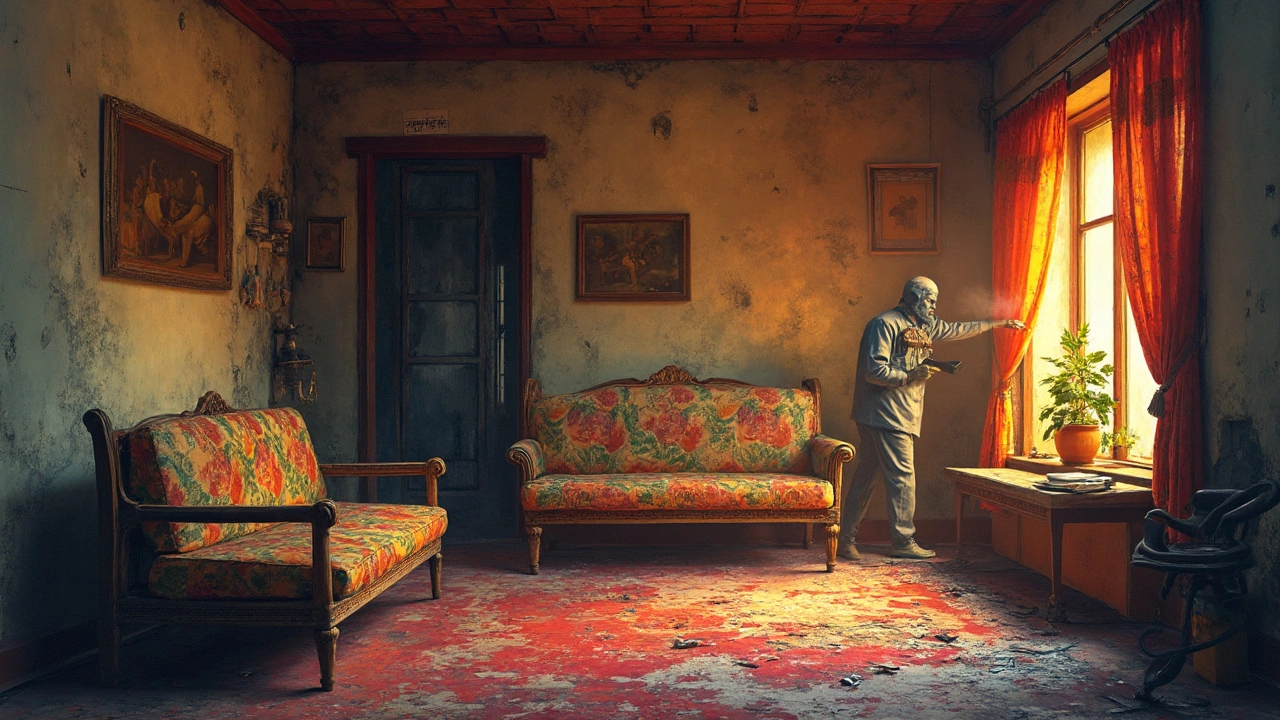Can You Get Sick from Mold in a Building?

Okay, so here’s the deal: mold can be sneaky, showing up in the places you least expect—even in brand new buildings. You might think fresh construction means a clean slate, but mold can pop up if conditions are just right. Dampness trapped during construction or materials left out in the rain can kickstart mold growth right from the start. And that’s just the beginning of the story.
Believe it or not, this isn't just about unsightly patches of green or black; mold can mess with your health in ways you might not imagine. Some folks get away with a few sniffles, while others deal with headaches, breathing issues, or worse. Basically, it's not something to brush off lightly.
Figuring out where mold hides and what to do about it is key. Checking out moisture-prone spots like basements, windows, and crawl spaces can be a game-changer. And trust me, if you spot mold or feel funny after spending time in a musty room, it's worth taking seriously. Solutions are out there; it just takes a little know-how and some quick moves.
- What is Mold and Where Does it Come From?
- The Health Risks Associated with Mold
- Mold in New Builds: A Surprising Problem
- How to Prevent Mold Growth in Your New Home
- What to Do if Mold is Found in Your Building
What is Mold and Where Does it Come From?
Mold is a type of fungus that grows from tiny spores floating around in the air. These spores are pretty much everywhere, so there's no dodging them entirely. When they land on a spot with the right conditions—think damp and warm—they start to grow and multiply.
You'll find mold in places you’d expect, like the bathroom or basement, but it can also show up in newly built homes if there's moisture trapped during the construction process. Imagine wooden beams sitting out in the rain during construction; that sets the perfect stage for mold growth from the get-go.
There are tons of different types of mold, but the usual suspects inside homes tend to be Cladosporium, Penicillium, and Aspergillus. These guys thrive on damp surfaces, especially if there's little airflow to dry the area out.
So where does a mold-friendly environment come from? It often sneaks in through water leaks or high humidity. Poor ventilation can trap moisture, letting mold turn a cozy corner of your building into its new home. New builds might also see mold due to improperly sealed windows or walls that let in moisture.
To get a handle on building health risks, knowing the source of dampness is key. Here’s a simple rundown on where to keep an eye out:
- Anywhere water might sneak in, like around plumbing fixtures or window seals.
- Areas that don't dry out easily, such as basements or crawl spaces.
- Spots with inadequate ventilation, like closed-off rooms or closets.
Addressing these moisture-prone areas quickly can make a big difference in keeping your space mold-free and your health intact.
The Health Risks Associated with Mold
Alright, here's the thing about mold exposure: it's not just a visual nuisance. It can actually mess with your well-being way more than you might expect. Mold releases tiny spores into the air, and when you breathe those in, it can lead to various health issues.
For some people, exposure can mean nasal stuffiness, throat irritation, coughing, or even skin rashes. If you're allergic, mold can be a real trigger. Then there are folks with asthma or compromised immune systems—mold can turn into a bigger problem. Think shortness of breath, wheezing, or even serious lung infections. Not pretty, right?
You've got certain types of mold that are more infamous than others, like black mold (Stachybotrys chartarum). It's known for its potential to cause chronic respiratory issues, so it's definitely one to watch out for.
Check this out—kids might have it worse when dealing with mold. There's some talk about mold exposure potentially leading to respiratory conditions down the road for the little ones, which is pretty concerning, right?
To keep these risks at bay, you really need to be on your toes. Make sure you’re keeping your indoor spaces dry and well-ventilated. If you're building or renovating, use mold-resistant materials, check for leaks regularly, and don't brush off any musty smells.
Long story short, being aware of building health risks associated with mold isn't just good sense—it's about keeping yourself and your loved ones safe from potential health issues. So, keep an eye out and take action when needed.

Mold in New Builds: A Surprising Problem
You’d think a brand new building would be the last place you’d find mold. But surprise, surprise—it’s more common than you’d expect! During construction, moisture can get trapped in various ways, like rain-soaked materials or improper sealing, setting the stage for an unwanted mold party.
Even with all the efforts to create energy-efficient homes, sometimes they end up being so tightly sealed that moisture has nowhere to go, leading to mold growth. A damp corner here or a leaky pipe there, and boom, you've got mold spreading its ugly roots.
“Mold issues in new buildings aren’t just about aesthetics; they can seriously affect indoor air quality and consequently your health,” says Dr. Helen Michaels, a leading expert in environmental health.
Mold in new constructions can be a hidden threat that builders and homeowners need to address proactively.
The good news is, understanding the problem allows you to outsmart it. Keep an eye out for areas like basements or laundry rooms where moisture stealthily accumulates. Regular inspections right from the start can save you a heap of trouble later.
In today’s housing market, new builds are supposed to be pristine, so spotting mold exposure might cause a mix of frustration and confusion. But don’t worry, taking the right steps can keep your new dream home safe and healthy.
| Common Moisture Sources | Indoor Mold Prevention Tips |
|---|---|
| Leaky roofs | Fix leaks and clean gutters regularly |
| Poor ventilation | Install exhaust fans and dehumidifiers |
| Wet building materials | Ensure materials are dry before installation |
How to Prevent Mold Growth in Your New Home
Keeping mold at bay in a brand-new home is easier than you might think, and it's totally worth the effort. The trick is to control moisture since mold loves damp places. Start by checking your home’s ventilation. Good airflow is key, so make sure your HVAC system is up to date and running smoothly. Opening windows and using exhaust fans in kitchens and bathrooms can help keep air circulating.
Next, keep an eye on humidity levels. Mold starts to thrive when indoor humidity creeps above 60%. A dehumidifier can be a game-changer, especially in places like basements. You can pick up a simple hygrometer at a hardware store to keep tabs on moisture levels.
Waterproofing is another biggie. Check your basement and roof for leaks or water entry points. Fixing cracks and ensuring proper grading around the house can direct water away from your foundation.
- Ensure your gutters are clean and functioning properly to prevent water from pooling near the foundation.
- Consider mold-resistant materials when building or renovating—not just for walls but also for insulation and flooring.
- Stay on top of cleaning, especially in areas prone to dampness. A regular wipe-down with mold-killing solutions can keep spores from settling in.
If you’re dealing with any water damage, act fast. Mold can begin growing in as little as 24 to 48 hours on wet surfaces, so time is of the essence.
| Ideal Humidity Level | Action to Take |
|---|---|
| Below 60% | Maintain as is |
| 60-70% | Use dehumidifiers |
| Above 70% | Avoid and remediate immediately |
Overall, being proactive can save you a lot of headaches down the road. Take these steps seriously and your home will stay comfortable and, most importantly, mold-free!

What to Do if Mold is Found in Your Building
Finding mold in your building is like discovering an unwelcome guest that's overstayed its welcome. First, don't panic, but don't ignore it either. Here's a no-nonsense guide to getting that pesky intruder out of your life for good.
Start by determining the extent of the mold situation. Mold exposure can be risky, so don't jump in bare-handed. Check the obvious places: basements, bathrooms, and any spots where water leaks might create a damp paradise for mold.
For small areas, you might tackle the cleanup yourself. Here's a plain and simple approach:
- Wear protective gear: Get yourself a good pair of gloves, a mask, and goggles. Mold and health issues pair about as well as socks and sandals.
- Scrub away: Use soap and water or a vinegar solution to scrub the mold off surfaces. No need for fancy products—keep it simple.
- Dry it out: After the scrubbing, drying is key. Mold loves moisture, so deprive it of that.
However, if you discover more than just a few patches, it’s time to call in the pros. Professional mold removal services have the tools and expertise to ensure the job’s done right and thoroughly. You’ll want to ensure not just removal but prevention of future outbreaks too.
Remember, mold isn't just a dirty smudge on your wall—it's a health hazard. For peace of mind and a healthy living environment, address it promptly. Regular inspections and maintenance can save you a lot of headaches down the road, ensuring your building stays mold-free and healthy.